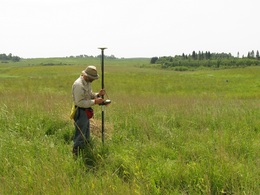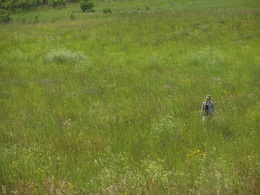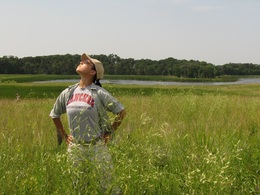I did some calculations of compatibility rates between pairs of half- and full-sibs while working on a revision of a paper about inbreeding depression in Echinacea. I started on the back on an envelope, but quickly moved to the flog because I did the calculations before, but lost the envelope. Here are the basic questions:
What proportion of matings between full-sib and half-sib Echinacea plants is compatible? Calculating a simple answer assuming no dominance in S-alleles is straightforward, but unrealistic. I think I started in the right direction toward a better answer. Comments appreciated.
Echinacea has a sporophytic self-incompatibility system. Plants don’t self because they have a self recognition mechanism that works like this: A plant produces pollen grains and stigmas that express products of two alleles at the S-locus. If either S-allele of a pollen grain is the same as either S-allele on the stigma, then the pollen grain won’t fertilize the ovule. To set seed an individual Echinacea plant needs pollen from another plant–and not just any plant.
If a pollen donor shares an S-allele with another plant, then its pollen grains won’t fertilize the ovules of the other plant. That pair is called “mating incompatible.” Mating incompatibility often occurs in pairs of related plants and sometimes between unrelated plants too. The extent of mating incompatibility among unrelated plants depends on how many total S-alleles are in a population.
So, here’s a basic question: What fraction of matings between full-sib Echinacea plants is compatible?
To answer it, designate each individual by its S-alleles: 12 is a plant with S-allele “1” and S-allele “2.”
The cross “12 x 12” represents selfing. It’s an incompatible cross.
The cross “12 x 34” represents mating between two plants that share no alleles. It’s a compatible cross.
The cross “12 x 13” represents mating between a pair that shares one allele. It’s an incompatible cross.
To designate some full-sibs, consider their parents first:
P: 12 X 34
There are four possible types of offspring resulting from this cross (F1s):
F1: 13, 14, 23, 24
Now, mate all possible combinations and note whether the cross is compatible. The below table summarizes the compatibility of all possible crosses. 13 x 13 in the upper left is mating incompatible. 13 X 24 is mating compatible.
F1 x F1
13 14 23 24
13 N N N Y
14 N N Y N
23 N Y N N
24 Y N N N
4 of 16 mating combinations between pairs of full siblings are compatible, 25%.
The next basic question is What fraction of matings between half-sib Echinacea plants is compatible?
If the mom is S-genotype is 12 and the first dad (sire 1) is 34, then there are three types of pollen donors for the second dad (the dad of the other half sib): dads with the same S-alleles as the first dad (sire 2a = 34), dads sharing one S-allele with the first dad (sire 2b = 35), and dads sharing no alleles with the first dad (sire 2c = 56).
Represent the mating of mom and sire 1 and their progeny like this:
P: 12 X 34
F1.1: 13, 14, 23, 24
The mating of mom and sire 2a, yields the following progeny:
P: 12 X 34
F1.2a: 13, 14, 23, 24
The mating of mom and sire 2b, yields the following progeny:
P: 12 X 35
F1.2b: 13, 15, 23, 25
The mating of mom and sire 2c, yields the following progeny:
P: 12 X 56
F1.2c: 15, 16, 25, 26
The following tables represent all combinations of the three types of half-sib crosses possible:
F1.1 x F1.2a
13 14 23 24
13 N N N Y
14 N N Y N
23 N Y N N
24 Y N N N
Just like full-sib crosses, 4 of 16 pairs are mating compatible, 25%.
F1.1 x F1.2b
13 14 23 24
13 N N N Y
15 N N Y Y
23 N Y N N
25 Y Y N N
6 of 16 mating combinations between these pairs of half siblings are compatible, 37.5%.
F1.1 x F1.2c
13 14 23 24
15 N N Y Y
16 N N Y Y
25 Y Y N N
26 Y Y N N
8 of 16 mating combinations between these pairs of half siblings are compatible, 50%.
So, 25 – 50% of pairs of half sib are mating compatible. As total S-allele diversity increases, half-sib compatibility would tend toward 50%.
These number don’t jibe with mate compatibility rates we’ve observed when crossing Echinacea siblings. In 1999 & 2000 we found that 68% of sib pairs (sibs from open pollinated materal plants) we attempted to cross were mating compatible, only 32% were incompatible.
The difference in theoretical and actual mating compatibility rates probably results from a bad assumption. The calculations above assume that there is no dominance among S-alleles. If one allele masks the expression of another, then it is much harder to answer the question. However, my first thought is that dominance will just increase the overall fraction of compatible mating pairs among siblings. It must be true for full siblings… I think.
Suppose that S-allele 1 is dominant to 3 (i.e. it masks the effect of allele 3), then for the original full sib scenario the 13 S-genotype behaves the same as a 11 S-genotype.
P: 12 X 34
F1: 13, 14, 23, 24
F1 x F1
13 14 23 24
13 N N Y Y
14 N N Y N
23 Y Y N N
24 Y N N N
6 of 16 mating combinations between these pairs of full siblings are compatible, 37.5%. Ah hah–a greater fraction of compatible mate pairs with one dominant S-allele!
Wait, it’s not so clear-cut because with dominance there are other possible combinations of parental S-genotypes that can generate full-sib progeny: 13 X 34, 13 X 33, and 12 X 33. Notice that homozygous S-genotypes become possible with dominance.
P: 13 X 34
F1: 13, 14, 33, 34
F1 x F1
13 14 33 34
13 N N Y Y
14 N N Y N
33 Y Y N N
34 Y N N N
6 of 16 mating combinations between these pairs of full siblings are compatible, 37.5%.
P: 13 X 33
F1: 13, 13, 33, 33
F1 x F1
13 13 33 33
13 N N Y Y
13 N N Y Y
33 Y Y N N
33 Y Y N N
8 of 16 mating combinations between these pairs of full siblings are compatible, 50%.
P: 12 X 33
F1: 13, 13, 23, 23
F1 x F1
13 13 23 23
13 N N Y Y
13 N N Y Y
23 Y Y N N
23 Y Y N N
8 of 16 mating combinations between these pairs of full siblings are compatible, 50%.
Ok, the introduction of one dominant allele does increase the overall fraction of compatible mating pairs among full siblings. I guess that adding more dominant S-alleles to a population would increase the proportion of full sib pairs that is compatible.
I’m guessing adding dominant S-alleles would increase the proportion of compatible matings between pairs of half-sibs too, but I am not sure. It’s too complicated for now.
One last thought, the dominance relationships among alleles may differ in pollen grains and stigmas. This probably occurs in Echinacea because we have observed the following non-reciprocal mating incompatibility: Pollen from plant A is mating compatible with plant B, but pollen from plant B is not mating compatible with plant A. Complicated, eh?
It was helpful for me to think through this. Please let me know if my reasoning is flawed. I’m sure folks have figured this out before. If you know who/where, please send me a reference!





-thumb-320x240-10991.jpg)
